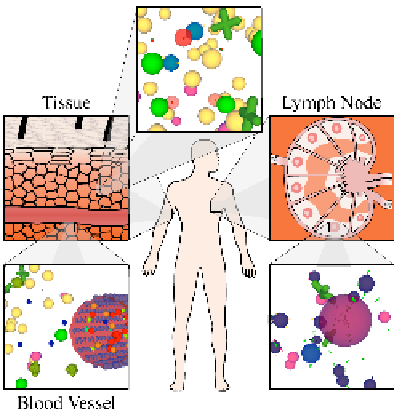Information Technology Reference
In-Depth Information
Fig. 1.
The decentralized defenses of immunity. Three compartmental modules, that
exhibit distinct but interconnected functionalities within the human immune system,
are implemented in our
IMMS:VIGO::3D
simulation environment: (1) tissue, (2) blood
vessels, and (3) lymph nodes.
resources, but also requires a modular and hierarchical design of the simulation
framework. Modelers - i.e., immunologists as well as researchers and students
in health sciences - should be able to look at the simulated immune system at
different levels of detail. The whole body simulation will not be as fine grained
as when looking at the interactions within a lymph node or at the intersection
between the lymphatic and vascular system.
In our current implementation we have incorporated three distinct, but inter-
connected sites within the human body that are related to the immune system:
-
Lymph Nodes:
Within a lymph node section we incorporate adaptive im-
mune system processes during clonal selection, in response to viral antigens
entering the lymph node. Different types of B cell strands can be defined.
In case of a high degree of matching with an antigen, rapid proliferation is
triggered.
-
Tissue:
Within a small section of tissue we model the immune system pro-
cesses during primary and secondary response reactions among viruses (with
their associated antigen components), tissue cells, dendritic cells, helper T
and killer T cells, memory and plasma B cells (with their associated anti-
bodies), and macrophages.
-
Blood Vessel-Tissue Interfaces:
At the interface between blood vessels
and tissue, we simulate red blood cells moving within a section of a blood
vessel, lined with endothelial cells, which can produce selectin and intercel-
lular adhesion molecules (ICAMs). This causes neutrophils to start rolling

